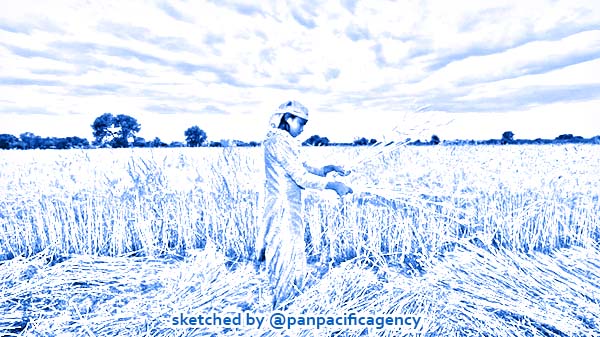[Analytics] Robots on the India’s farm

A farmer harvesting wheat crop in Ghaziabad district of Uttar Pradesh (India) during coronavirus lockdown in April. (Photo: PTI). Sketched by the Pan Pacific Agency.
To meet the ever-increasing food demand, existing farmlands need to be more productive and cost-effective. In most developed nations, farms are building new technologies to increase and squeeze out productivity; in India, however, the low rate of farm mechanisation presents an opportunity. The overall farm mechanisation in India has been lower at 40-45 per cent compared to other countries such as the US (95 per cent), Brazil (75 per cent) and China (57 per cent). Abhinav Mehra speciallly for the e27.
While tractor sales continue to increase in the country, affordability still remains a hurdle. This calls for not only capital expenditure light solutions but also innovative new go to market models. All of this is embodied in India based robotics startup – TartanSense.
TartanSense, is building small robots for small farmers with a mission to augment the current farm mechanisation effort in India and eventually similar countries with intelligent robots, capable of carrying out both simple and complex farm tasks, reduce labour dependence, and improve overall productivity.
Meet Brijbot the AI robot as a service
Jaisimha Rao, the founder of TartanSense, returned to India after spending a decade as a trader in Wall Street. Owning a coffee plantation in Karnataka, India, he decided to spend a few months there and began to understand how things worked on the farm.
Rao noticed that a lot of decisions were taken just based on a hunch or historic knowledge and actions on the farm didn’t seem to be backed by data or real-time insight at all. This sparked an idea to start TartanSense, a company to make agriculture more data-driven.
The company is built on the idea of getting on the edge of AI to work with a semi-autonomous rover capable of traversing agricultural fields and carrying out an intelligent end actuator function, which would have otherwise been done by a human or an unintelligent machine.
Their first product Brijbot is an AI-driven 250kg robot that can identify weeds from cotton and spray herbicide with 98 per cent precision, effectively de-weeding cotton farms. TartanSense has managed to go from the first prototype to the first iteration of their product in less than a year. Later this month as the weeding requirements begin for cotton fields will see the commercial launch of the Brijbot on Indian farms.
TartanSense deploys Brijbot in a pay-per-use service model charging farmers per acre of de-weeding. This allows farmers to start their mechanisation journey in an affordable manner without having to buy capital heavy assets.
In delivering the robot as a service, the objective is to have direct farmer engagement through a team of ground staff in the respective provinces. In the initial seasons, the Brijbots that will be used will all be TartanSense owned and managed. Post multiple product development cycles, as Brijbot evolves to become easy to own and operate, the business model will also evolve to permit outright sales.
Leapfrogging the productivity curve of Indian farms
In the age of data and technology, it is a surprise to see that most farming in India is not backed by data or real-time insight. Reliance on archaic methods and hunches seemed to have significantly reduced productivity and subsequently the yield.
Alongside this problem, the TartanSense team also noticed the extent to which farming was labour dependent. In an operation such as de-weeding, a good amount of dexterity was required to carry out the job which had made it very difficult to carry out without labour dependence.
They realised that if they could build products with a combination being data-driven and being able to carry out tasks that would otherwise require a human, it could play a role in improving the overall productivity of farms in India and successfully build a large business in doing so.
TartanSense is among the 11 startup finalists at Future Food Asia 2020, and as the startup begins to expand, the visibility provided by the platform will help open a lot more doors for them in the agritech ecosystem in new markets.
Bots on the ground
While COVID-19, has a silver lining for solution offerings such as Brijbot, it also disrupts their own product development supply chain. With India moving in and out pandemic induced lockdowns inter-state labour travel has been restricted and so farmers may be more open to the idea of using a robot for their weeding needs.
However, being a robotics startup based out of India, they have to continuously work to ensure that the hardware and equipment needed by their teams are available without delays. The quality of the supply chain has a direct impact on the price point at which their products can be made available to farmers.
Rao says, “We have seen a lot of robotics and farm machinery companies building solutions to work on large farms and admire how some of these solutions work perfectly for the scale they are built to operate for. However, there exists a very large market in catering to the needs of smaller, sub-10-acre farmers.”
“That is what we are looking to address, making sure that intelligent machines that mechanise farm work are made available to farmers with smaller landholdings in countries like India at a reasonable price point.”